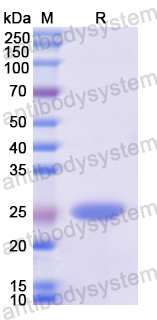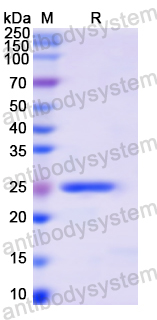Catalog No.
YHD31601
Expression system
E. coli
Species
Homo sapiens (Human)
Protein length
Ala238-Ser450
Predicted molecular weight
26.26 kDa
Nature
Recombinant
Endotoxin level
Please contact with the lab for this information.
Purity
>90% as determined by SDS-PAGE.
Accession
P19012
Applications
ELISA, Immunogen, SDS-PAGE, WB, Bioactivity testing in progress
Form
Lyophilized
Storage buffer
Lyophilized from a solution in PBS pH 7.4, 0.02% NLS, 1mM EDTA, 4% Trehalose, 1% Mannitol.
Reconstitution
Reconstitute in sterile water for a stock solution. A copy of datasheet will be provided with the products, please refer to it for details.
Shipping
In general, proteins are provided as lyophilized powder/frozen liquid. They are shipped out with dry ice/blue ice unless customers require otherwise.
Stability and Storage
Use a manual defrost freezer and avoid repeated freeze thaw cycles. Store at 2 to 8°C for frequent use. Store at -20 to -80°C for twelve months from the date of receipt.
Alternative Names
KRT15, Cytokeratin-15, Keratin-15, KRTB, K15, CK-15, Keratin, type I cytoskeletal 15
3D Biomimetic Liver Cancer Model: Diethylnitrosamine-Induced Proteomic Dysregulations in Stromal-Epithelial Milieu., PMID:40475465
WGCNA-ML-MR integration: uncovering immune-related genes in prostate cancer., PMID:40260298
Mass spectrometric detection of keratins in tear fluid., PMID:39761842
Epithelial differentiation of gingival mesenchymal stem cells enhances re-epithelialization for full-thickness cutaneous wound healing., PMID:39609719
Histological, histochemical, and immunohistochemical characterization of NANOULCOR nanostructured fibrin-agarose human cornea substitutes generated by tissue engineering., PMID:39538248
Gene expression changes in mouse lung induced by subacute inhalation of PM10-rich particulate matter., PMID:39388309
Upregulation of keratin 15 is required for varicella-zoster virus replication in keratinocytes and is attenuated in the live attenuated vOka vaccine strain., PMID:39385182
Over-expression of KRT17 and MDK genes at mRNA levels in urine-exfoliated cells is associated with early non-invasive diagnosis of non-muscle-invasive bladder cancer., PMID:39069115
Comprehensive analysis of aberrantly methylated differentially expressed genes and validation of CDC6 in melanoma., PMID:39052109
Upregulation of caveolae-associated structural proteins in the hair follicle bulge of lichen planopilaris and frontal fibrosing alopecia., PMID:38837051
High keratin 15 expression reflects favorable prognosis in early cervical cancer patients., PMID:38639842
Keratin 5 basal cells are temporally regulated developmental and tissue repair progenitors in bladder urothelium., PMID:38634130
Comparative Characterization of Human Meibomian Glands, Free Sebaceous Glands, and Hair-Associated Sebaceous Glands Based on Biomarkers, Analysis of Secretion Composition, and Gland Morphology., PMID:38542083
Effects of autoimmune abnormalities on fertility and placental morphology in mice., PMID:38389171
ASCL2 is a key regulator of the proliferation-differentiation equilibrium in the esophageal epithelium., PMID:38252116
SOX4 reversibly induces phenotypic changes by suppressing the epithelial marker genes in human keratinocytes., PMID:38227121
Study on Potential Differentially Expressed Genes in Idiopathic Pulmonary Fibrosis by Bioinformatics and Next-Generation Sequencing Data Analysis., PMID:38137330
Omics-CNN: A comprehensive pipeline for predictive analytics in quantitative omics using one-dimensional convolutional neural networks., PMID:38027840
Keratin 15 protects against cigarette smoke-induced epithelial mesenchymal transformation by MMP-9., PMID:38007424
Photobiomodulation Facilitates Rat Cutaneous Wound Healing by Promoting Epidermal Stem Cells and Hair Follicle Stem Cells Proliferation., PMID:37882982
Prognostic analyses of genes associated with anoikis in breast cancer., PMID:37842046
KRT15 in early breast cancer screening and correlation with HER2 positivity, pathological grade and N stage., PMID:37814985
Silencing of keratin 15 impairs viability and mobility while facilitating the doxorubicin chemosensitivity by inactivating the β‑catenin pathway in liver cancer., PMID:37720670
Machine learning approach to screen new diagnostic features of adamantinomatous craniopharyngioma and explore personalised treatment strategies., PMID:37305719
Tumor keratin 15 expression links with less extent of invasion and better prognosis in papillary thyroid cancer patients receiving tumor resection., PMID:37243844
Clinical Implication of Keratin-15 Quantification for Renal Cell Carcinoma Management: Its Dysregulation and Association with Clinicopathologic Characteristics and Prognostication., PMID:36858509
Krt14 and Krt15 differentially regulate regenerative properties and differentiation potential of airway basal cells., PMID:36512409
Exosomes Derived from Dermal Papilla Cells Mediate Hair Follicle Stem Cell Proliferation through the Wnt3a/β-Catenin Signaling Pathway., PMID:36388171
Upregulated keratin 15 links to the occurrence of lymphovascular invasion, stromal cervical invasion as well as unfavorable survival profile in endometrial cancer patients., PMID:35866777
A unique skin phenotype resulting from a large heterozygous deletion spanning six keratin genes., PMID:35822506
The combined effects of Map3k1 mutation and dioxin on differentiation of keratinocytes derived from mouse embryonic stem cells., PMID:35798792
KRT15 promotes colorectal cancer cell migration and invasion through β-catenin/MMP-7 signaling pathway., PMID:35477819
Barrett's Metaplasia Progression towards Esophageal Adenocarcinoma: An Attempt to Select a Panel of Molecular Sensors and to Reflect Clinical Alterations by Experimental Models., PMID:35328735
Decreased Plasma Level of Cytokeratin 20 (KRT20) Is Indicative of the Emergence and Severity of Acute GvHD Irrespective to the Type of Organ Involvement., PMID:35327321
Transcriptomic Analysis of Breast Cancer Patients Sensitive and Resistant to Chemotherapy: Looking for Overall Survival and Drug Resistance Biomarkers., PMID:34981997
Epithelium Replacement Contributes to Field Expansion of Squamous Epithelium and Ulcerative Colitis-Associated Neoplasia., PMID:34597671
Fine-tuned repression of Drp1-driven mitochondrial fission primes a 'stem/progenitor-like state' to support neoplastic transformation., PMID:34545812
Conditional Deletion of AP-2β in the Periocular Mesenchyme of Mice Alters Corneal Epithelial Cell Fate and Stratification., PMID:34445433
TMT-Based Quantitative Proteomic Analysis Reveals the Effect of Bone Marrow Derived Mesenchymal Stem Cell on Hair Follicle Regeneration., PMID:34194323
Desmoplastic Trichoepithelioma With Pseudocarcinomatous Hyperplasia: A Folliculosebaceous Neoplasm in Young Persons., PMID:33899770
Tunnel vision: Imaging the mouse epididymis in three-dimensions., PMID:33716171
Human gastrointestinal epithelia of the esophagus, stomach, and duodenum resolved at single-cell resolution., PMID:33691112
GATA4 blocks squamous epithelial cell gene expression in human esophageal squamous cells., PMID:33547361
Transcriptome Analysis of lncRNA-mRNA Interactions in Chronic Atrophic Gastritis., PMID:33505433
Identification, Validation, and Functional Annotations of Genome-Wide Profile Variation between Melanocytic Nevus and Malignant Melanoma., PMID:32934956
Deletion of p53 and Hyper-Activation of PIK3CA in Keratin-15+ Stem Cells Lead to the Development of Spontaneous Squamous Cell Carcinoma., PMID:32916850
Histopathological effect of pterostilbene as chemoprevention in N-nitroso-tri-chloroethylurea (NTCU)-induced lung squamous cell carcinoma (SCC) mouse model., PMID:32893871
Severe epidermolysis bullosa simplex phenotype caused by codominant mutations p.Ile377Thr in keratin 14 and p.Gly138Glu in keratin 5., PMID:32885477
Fibrotic trochanters: A potential mechanism for stem cell depletion in scarring alopecias., PMID:32844450
Transcriptome Profiling and Differential Gene Expression in Canine Microdissected Anagen and Telogen Hair Follicles and Interfollicular Epidermis., PMID:32759649



